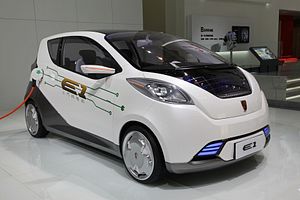Everyone loves China’s five-year plans. They tell you everything you need to know about the future direction of the Chinese economy: intentions and priorities, along with timetables and targets. The only thing missing are the results. After five years, though, who keeps track of what was promised and what was delivered? Well, the Chinese government for one. And as Beijing takes stock of its efforts to become a world leader in the production and deployment of electric and hybrid electric cars during the Twelfth Five-Year Plan (2011-2015), the picture isn’t pretty. Now Beijing is attempting a mid-plan course correction. Will it work?
First, where does Beijing want to be and where is it now? In 2009, the government-established targets for pure electric and hybrid electric vehicles of 500,000 by 2015 and 5 million by 2020. Its original “ten cities, thousand vehicles” program, launched that same year, planned for ten cities to develop 1,000 electric vehicles each; by 2011, the list of cities had expanded to twenty-five. Subsidies of 50,000-60,000 yuan ($8,000-9,600) were offered to consumers who purchased the cars. (By one account, however, central and local government subsidies can reach as high as $16,500 on cars priced $32,900-49,400. By the end of 2012, however, only seven of the twenty-five cities had met their 1,000 car target. And in 2013, only 17,600 hybrid and electric vehicles (cars and buses) were sold. According to a NewsChina Magazine report in April 2014, “with one year to go, China is still about 480,000 units away from meeting its first stated target.” This early report card is not only dismal but also dangerous for a country facing skyrocketing air pollution and a related public health crisis. Moreover, China’s annual automobile sales, already the largest in the world, have not even begun to achieve their potential.
Fortunately for Beijing, a team of American and Chinese researchers has undertaken a study in the Stanford Social Innovation Review that offers some guidance as to what in the current Chinese strategy is working and what is not. What is working? Of the five initial pilot cities—Beijing, Shanghai, Shenzhen, Hangzhou, and Chongqing—the research team cites Shenzhen’s partnership with the Potevio New Energy and China Southern Power Grid as a winner, enabling a successful electric bus leasing effort. Hangzhou’s Kandi electric car-sharing service, modeled on the city’s effective bicycle rental business, also produced a successful trial.
What isn’t working? Among other things, cities are inflating their statistics to get more preferential tax and financial treatment; local protectionism means that cities are developing regulations that serve their own electrical vehicle (EV) industry interests and prevent much-needed competition from outside the region; in some cities there is little-to-no incentive to develop the charging infrastructure necessary to support an EV market, and in others, there is too much infrastructure development. As Caixin reported in February 2014, a Potevio official stated, “Companies went crazy by building huge numbers of charging stations all at once. After reality set in, the investment interest slowed; State Grid, Southern Grid and Potevio cut investments in electric car infrastructure.” Also challenging is the decision by Chinese car makers and the utilities to develop different charging standards. The most prominent homegrown EV car maker BYD, based in southern China, now reportedly has to develop its own charging stations in northern China. Finally, as other analysts have noted, the Chinese people are concerned about the safety of the domestic EV cars, which some domestic experts have argued have not been thoroughly tested or evaluated.
Beijing is responding to these weaknesses with a raft of new regulations. The government has promised to drop pilot cities that fail to meet their targets; to ensure that new government vehicle procurement is at least 30 percent EVs; to offer subsidies to consumers based on the mileage of the EV rather than the type of EV; and, in an effort to work around local protectionism—30 percent of vehicles for sale should be from other places. Consumer subsidies will continue but will be reduced.
The promise is there. Other Chinese cities can learn from Hangzhou; for the mid-to-lower end consumer, an EV car-sharing/rental market would be a huge boon. At the upper end, China now boasts a rapidly expanding middle class, as well as more than 1 million millionaires and, by some accounts, as many as 300 billionaires. These are all candidates to become individual EV owners. Beijing, along with other cities facing both enormous air pollution and traffic gridlock, could consider special HOV lanes for EVs. Given Beijing’s directive on EV government procurement, such HOV lanes would no doubt be welcomed by officials as well. Finally, Beijing could offer foreign-made EVs, such as Tesla, the same benefits of tax-exemption and avoidance of the license plate lotteries in cities such as Beijing, Shanghai, and Guangzhou that Chinese-made EVs receive. Pushing forward on green-tech cars should also be a spur to green energy; if not, much of the environmental benefit of the electric cars will be wasted considering all the coal that will be burned to provide the electricity to charge the cars’ batteries.
There is no guarantee that even China’s new regulations will produce the great leap forward in electric vehicle use that Beijing desires. That decision rests in the hands of Chinese consumers. But with more and more Chinese choking on the country’s current growth model, the Chinese public may see EVs as less of a choice and more of a necessity. Full speed ahead.
Elizabeth C. Economy is C.V. Starr Senior Fellow and Director for Asia Studies at the Council on Foreign Relations. She is an expert on Chinese domestic and foreign policy and U.S.-China relations and author of the award-winning book, The River Runs Black: The Environmental Challenge to China’s Future. She blogs at Asia Unbound, where this piece originally appeared.
































